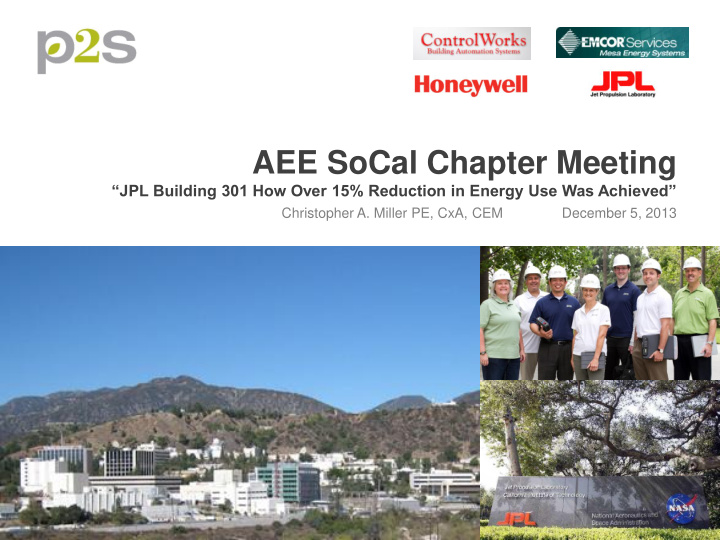



AEE SoCal Chapter Meeting “JPL Building 301 How Over 15% Reduction in Energy Use Was Achieved” Christopher A. Miller PE, CxA, CEM December 5, 2013
What are Common Obstacles In Achieving Energy Reductions? • Saying That Everything That Could Be Done Has • No Feedback How Systems Are Operating • Decoupling Comfort Complaints With Performance • No Standards for Change of Use Within the Building • Operating or Changing Set Points Manually • Designing or Operating By Rules of Thumb
Building 301 • Project Formulation Building • 170,000 Square Foot 4 Story Building • (2) 250 Ton Chillers • (2) 80,000 CFM 100- HP AHU’s that are interconnected • (2) 30-HP AHU Return Fans • 33 Fan Coil Units for High Load or Critical Areas • Mixed Use building Offices, Labs, & Data Rooms • Server Racks Everywhere Mixed In
Project #1 Chiller Replacement (2009) • Electrical Consumption was over 3.7 Million kWh • Served from a Central Cooling Tower (B315) with Primary- Secondary-Tertitary Constant Flow CW Pumping • CHW was Primary Constant Flow • Originally project was to add a Pony Chiller • Convinced Honeywell & JPL to meter performance and instead replace the chillers.
Project #1 Chiller Replacement (2009)
Project #1 Chiller Replacement (2009) • (2) McQuay (Daikin) 250 Ton WMC’s • VFD’s Added to CHW & Condenser Water Pumps • CHW Converted to Primary Variable Flow • The Decoupler was Removed from the CW • CW was converted to Variable Flow Secondary Boosted • All Operating Setpoints are Reset by Demand or Relation • Project resulted in over 700,000 kWh in Savings • CW of other buildings were Converted to Constant Flow Secondary Boosted By Maintenance Staff For Even More Savings to the Lab Not Claimed by this Project.
Project #2 Hybrid VAV & Controls Upgrade (2012) • New study of energy projects on lab performed 2010-2011 • Found Rule of thumb sequences with the AHU and zones • Enthalpy Economizer not operating correctly • Chiller Plant operated 24-7 due to critical fan coil loads • One AHU Ran 24-7 due to server additions • During winter chiller plant cycles on/off even with a flywheel mode multiple times
Project #2 Hybrid VAV & Controls Upgrade (2012) • System/Sequence Operates based on Demand • Winter AHU operates 24-7 with Economizer for all loads • Chiller plant cycles less in winter, on 10, off 40 minutes. • Summer Time only Fan Coils operate at night…. • Until an unknown server with out a fan coil was found. • Spaces cooler, was operating at 78 deg F, now 74 deg F • Less Complaints • Still more savings available • VAV Reheat Coils Plugged, Reheat Valves Leak by • Isolation dampers on AHU do not close off • On track for about 800,000 kWh Savings
How to Serve Critical Spaces Efficiently • IDF – Intermediate Distribution Frame (Typ. 0.5 to 2 Tons) • BDF – Building Distribution Frame (2 to 10 Tons) • MDF – Main Distribution Frame (5 to ? Tons) • Typically IDF’s are served by Mini Spilts and VRF Systems • Typically BDF’s are served by Ceiling Computer Rm Units • Typically MDF’s are served by Floor Standing CRU’s • Why?
How to Serve Critical Spaces Efficiently • In the past controls were not accurate (8 bit A to D) • 256 points of resolution vs. 4096 today • Use hybrid solution for small to medium rooms • Use dedicated AHU’s for Larger Rooms • Less internal DP • Hot Water Reheat • VFD Efficient Fans • Quieter spaces, more room inside the data room • Just as reliable • Use External Adiabatic Humidifiers
Thank You! Q & A AEE SoCal Chapter Meeting December 5, 2013
Recommend
More recommend